Direct interaction between the TnsA and TnsB subunits controls the heteromeric Tn7 transposase
- PMID: 23674682
- PMCID: PMC3670325
- DOI: 10.1073/pnas.1305716110
Direct interaction between the TnsA and TnsB subunits controls the heteromeric Tn7 transposase
Abstract
The transposon Tn7 transposase that recognizes the transposon ends and mediates breakage and joining is heteromeric. It contains the Tn7-encoded proteins TnsB, which binds specifically to the transposon ends and carries out breakage and joining at the 3' ends, and TnsA, which carries out breakage at the 5' ends of Tn7. TnsA apparently does not bind specifically to DNA, and we have hypothesized that it is recruited to the ends by interaction with TnsB. In this work, we show that TnsA and TnsB interact directly and identify several TnsA and TnsB amino acids involved in this interaction. We also show that TnsA can stimulate two key activities of TnsB, specific binding to the ends and pairing of the Tn7 ends. The ends of Tn7 are structurally asymmetric (i.e., contain different numbers of TnsB-binding sites), and Tn7 also is functionally asymmetric, inserting into its specific target site, attachment site attTn7 (attTn7) in a single orientation. Moreover, Tn7 elements containing two Tn7 right ends can transpose, but elements with two Tn7 left ends cannot. We show here that TnsA + TnsB are unable to pair the ends of a Tn7 element containing two Tn7 left ends. This pairing defect likely contributes to the inability of Tn7 elements with two Tn7 left ends to transpose.
Keywords: asymmetric transposon ends; protein-DNA interaction; protein–protein interaction; transposition.
Conflict of interest statement
The authors declare no conflict of interest.
Figures
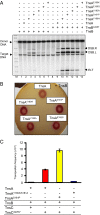
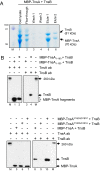
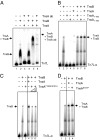
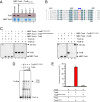
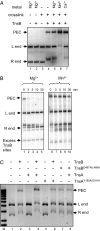

Similar articles
-
The Tn7 transposition regulator TnsC interacts with the transposase subunit TnsB and target selector TnsD.Proc Natl Acad Sci U S A. 2014 Jul 15;111(28):E2858-65. doi: 10.1073/pnas.1409869111. Epub 2014 Jun 30. Proc Natl Acad Sci U S A. 2014. PMID: 24982178 Free PMC article.
-
Alternative interactions between the Tn7 transposase and the Tn7 target DNA binding protein regulate target immunity and transposition.EMBO J. 2003 Nov 3;22(21):5904-17. doi: 10.1093/emboj/cdg551. EMBO J. 2003. PMID: 14592987 Free PMC article.
-
Architecture of the Tn7 posttransposition complex: an elaborate nucleoprotein structure.J Mol Biol. 2010 Aug 13;401(2):167-81. doi: 10.1016/j.jmb.2010.06.003. Epub 2010 Jun 9. J Mol Biol. 2010. PMID: 20538004 Free PMC article.
-
Tn7.Microbiol Spectr. 2014 Oct;2(5). doi: 10.1128/microbiolspec.MDNA3-0010-2014. Microbiol Spectr. 2014. PMID: 26104363 Review.
-
Heteromeric transposase elements: generators of genomic islands across diverse bacteria.Mol Microbiol. 2014 Sep;93(6):1084-92. doi: 10.1111/mmi.12740. Epub 2014 Aug 19. Mol Microbiol. 2014. PMID: 25091064 Review.
Cited by
-
Insight into the molecular mechanism of the transposon-encoded type I-F CRISPR-Cas system.J Genet Eng Biotechnol. 2023 May 16;21(1):60. doi: 10.1186/s43141-023-00507-8. J Genet Eng Biotechnol. 2023. PMID: 37191877 Free PMC article. Review.
-
Mechanistic details of CRISPR-associated transposon recruitment and integration revealed by cryo-EM.Proc Natl Acad Sci U S A. 2022 Aug 9;119(32):e2202590119. doi: 10.1073/pnas.2202590119. Epub 2022 Aug 1. Proc Natl Acad Sci U S A. 2022. PMID: 35914146 Free PMC article.
-
Transposons and CRISPR: Rewiring Gene Editing.Biochemistry. 2023 Dec 19;62(24):3521-3532. doi: 10.1021/acs.biochem.2c00379. Epub 2022 Sep 21. Biochemistry. 2023. PMID: 36130724 Free PMC article.
-
Metagenomic discovery of CRISPR-associated transposons.Proc Natl Acad Sci U S A. 2021 Dec 7;118(49):e2112279118. doi: 10.1073/pnas.2112279118. Proc Natl Acad Sci U S A. 2021. PMID: 34845024 Free PMC article.
-
Avoiding the ends: internal epitope tagging of proteins using transposon Tn7.Genetics. 2015 May;200(1):47-58. doi: 10.1534/genetics.114.169482. Epub 2015 Mar 5. Genetics. 2015. PMID: 25745023 Free PMC article.
References
-
- Craig NL, Craigie R, Gellert M, Lambowitz A. Mobile DNA II. Washington, DC: ASM; 2002.
-
- Peters JE, Craig NL. Tn7: Smarter than we thought. Nat Rev Mol Cell Biol. 2001;2(11):806–814. - PubMed
-
- Li Z, Craig NL, Peters JE. 2013. in Bacterial Integrative Mobile Genetic Elements, eds Roberts A, Mullany P (Landes Bioscience, London), pp. 1–32.
-
- May EW, Craig NL. Switching from cut-and-paste to replicative Tn7 transposition. Science. 1996;272(5260):401–404. - PubMed
Publication types
MeSH terms
Substances
Grants and funding
LinkOut - more resources
Full Text Sources
Other Literature Sources
Molecular Biology Databases

